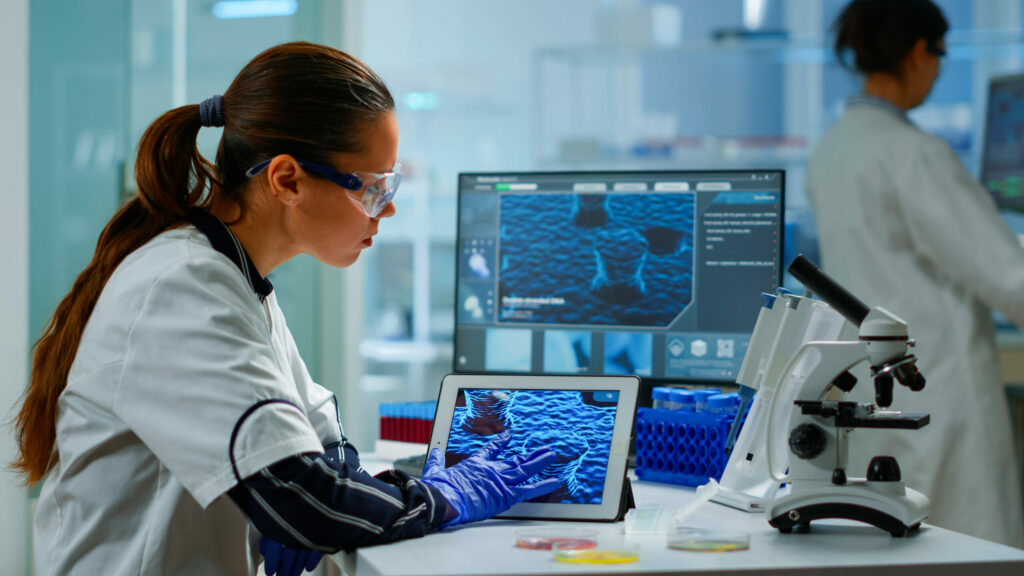
No industry is immune to cyber attacks. But the threats to cyber security that life sciences companies and organizations face are especially serious.
The substantial amounts of data, intellectual property, and money the life sciences industry handles prove irresistible to criminals. This industry’s exposure to cyber risk ranks second only to high tech’s, according to Accenture.
ProWriters can help you educate your life sciences clients about their high level of risk. We can also assist you in equipping them to mitigate and reduce it.
Why the Life Sciences Sector Faces Major Cyber Risk
The life sciences sector includes organizations in a wide range of fields working to improve health and quality of life: pharmaceuticals, biotechnology, medical devices, and more. Billions of dollars flow through this industry. Analysts expect its size and value will only grow in the years ahead.
But some key characteristics of the life sciences industry raise its cyber risk.
Large-Scale Collection of Data
Life sciences organizations depend on data, and lots of it. Data reveal health trends and hazards, establish pharmaceuticals’ efficacy in clinical trials, guide patients’ customized medical care, and optimize research and development, among other outcomes.
But a big amount of data brings big risks.
Criminals may want personal information so they can commit identity theft. They also may want to make fast money using ransomware to hold that information hostage. Electronic health records, prescription histories, records from clinical trials, patient testimonials—these and other data sources are all potential targets.
The health care industry has seen the average cost of a data breach hit a high of $10.10 million, according to IBM. Among pharmaceutical companies alone, the average cost has reached just over $5 million. By 2024, per Accenture, cyber attacks could jeopardize $642 billion in life sciences worldwide.
Importance of Intellectual Property
From newly developed biotechnologies and medical devices to patents on drug formulas, and much else, life sciences intellectual property (IP) is extremely valuable. It can account for up to 80% of a life sciences company’s value, according to Deloitte.
In this industry, 95% of cyber crime relates to IP theft.
Sometimes, IP thieves are hackers based in foreign countries. They may be sponsored by governments seeking to give their country’s companies an advantage.
More often, the threat is internal. IP and FDA law practice Upadhye Tang states it sees employees stealing trade secrets when they get ready to leave a company for a new job or start their own business. Internal thieves can also act on foreign governments’ behalf.
Additionally, employees can jeopardize IP accidentally. A misdirected or inappropriately forwarded email, a file shared too widely, or injudicious text messages can be all it takes to lose IP.
Involvement in Controversial Social and Ethical Issues
Research and development in life sciences frequently involve controversial issues. As a result, companies can find themselves in hacktivists’ crosshairs. Hacktivists attack and disrupt computer systems to promote social, political, and ethical agendas.
Because they generally claim no monetary motive, they rarely use ransomware—though some experts say this tendency could change. Raymond Pompon, director of F5 Labs, identifies hacktivists’ three main tactics:
- Distributed Denial of Service (DDoS) attacks: Overwhelming the targeted server or network with traffic to disrupt normal functioning.
- Doxing: Stealing proprietary or personal information (“docs,” from documents) and posting it online to shame, harass, and threaten targets.
- Defacement: Changing websites’ appearances or subverting electronic systems to send a message.
How Life Sciences Companies Can Strengthen Cyber Security
Cyber attacks against life sciences organizations lead to loss of revenue, competitive advantage, and reputation. They also threaten people who depend on the drugs, medical devices, and other products and services these companies make possible.
The industry is a uniquely tempting target for cyber crime. However, improving life sciences cyber security involves the same approaches and solutions other industries use.
Companies must:
- Assess and prioritize areas of greatest risk. This process demands decision-makers have access to robust, reliable analytics.
- Review all security measures, upgrading some and implementing others. From secure email gateways to multifactor authentication, readily available but often underutilized cyber security controls can reduce risk.
- Work with third-party cyber security professionals to monitor networks and manage endpoint security in real time. Quick detection and isolation of cyber threats reduce their impact. They also help companies recover with minimal disruption and damage.
- Develop an incident response plan. A detailed plan outlines what to do and whom to contact: forensic IT professionals, legal counsel, or others. Organizations should also have a readily accessible one- or two-page “grab sheet” that includes key contact details and other immediately necessary information.
- Educate all personnel on a continual basis about cyber risk. Make them aware of the latest threats and how they can help keep data and operations secure.
Educate Your Life Sciences Clients About Cyber Insurance
What’s the best way a broker can help improve life sciences clients’ cyber security?
Educate them about the importance of strong Cyber Liability Insurance, and facilitate their purchase of the policy that best fits their needs.
The costs of cyber attacks and data breaches can add up, including:
- Ransomware payments
- IT forensic investigations
- Data recovery and network repair
- Notification of customers, vendors, and other third parties
- Legal representation
Cyber Insurance can cover these and other expenses. It can help life sciences companies meet the crisis and move forward in their work more quickly and securely.
Help your life sciences clients, as well as clients in other industries, understand their cyber risk and how Cyber Liability Insurance can protect them. Download our free eBook, Cyber Exposure: What’s the Real Cost, today.

